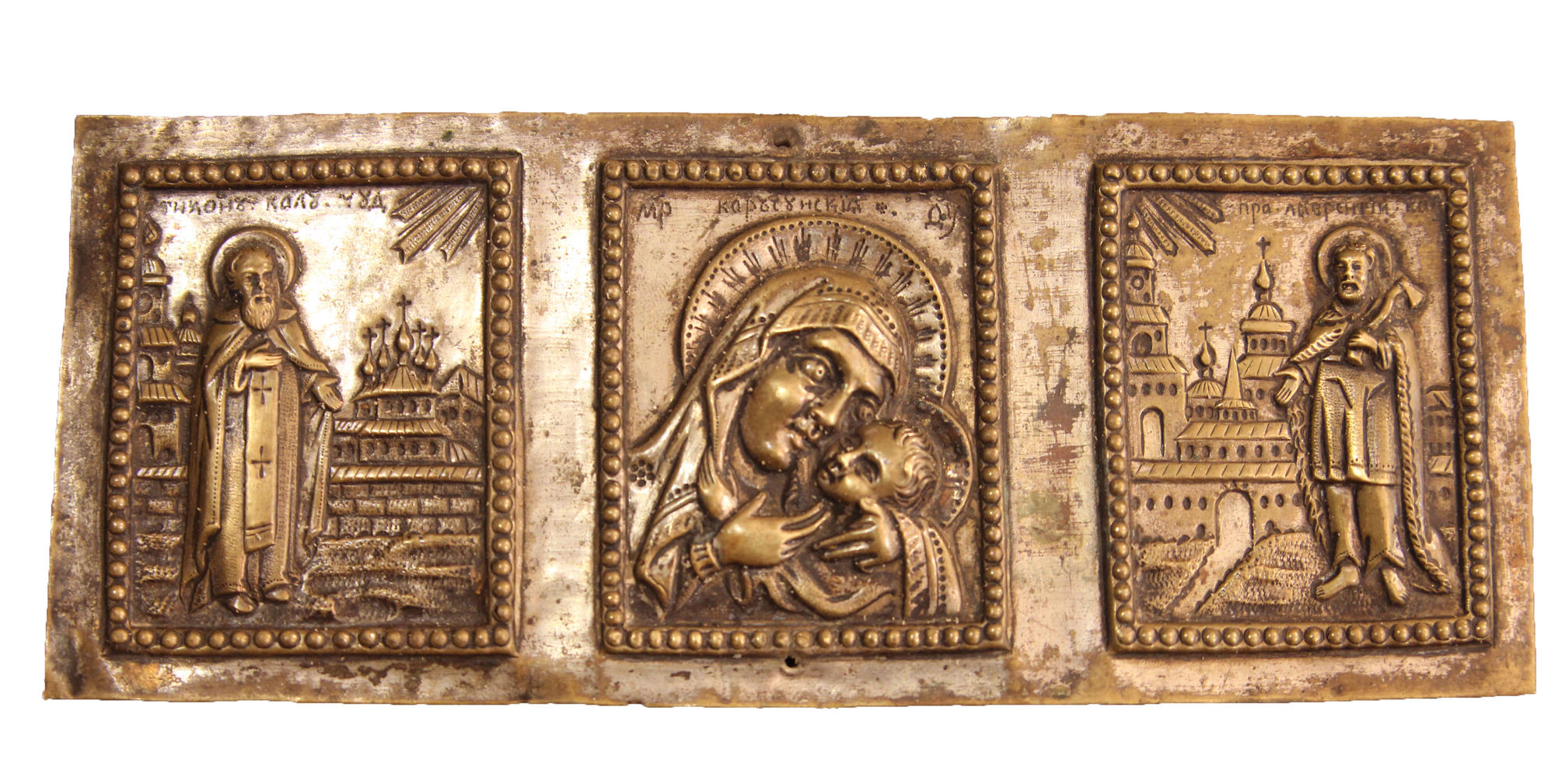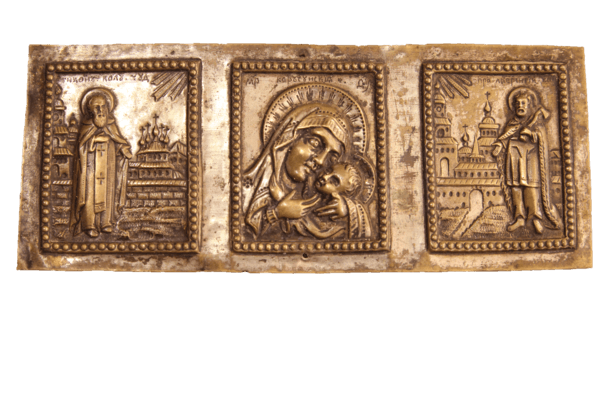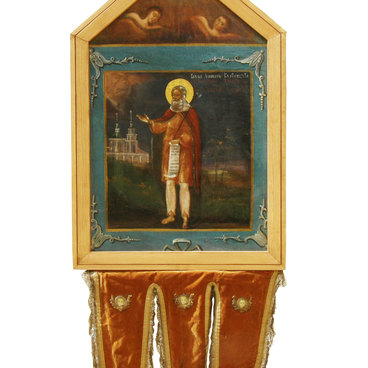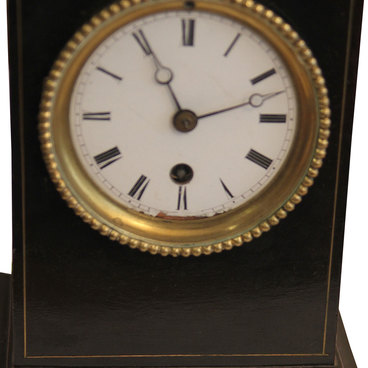The icon presented at the exposition is called a tripartite icon as it consists of three images. The central part is the Korsun icon of Our Lady, while the left and right parts are the icons of the Kaluga saints – Blessed Laurentius of Kaluga and Right Reverend Tikhon of Kaluga, respectively.
Legend has it that the Korsun icon was painted by the holy Apostle Luke in the city of Korsun. A copy of it was brought to Kiev by Prince Vladimir in 988. The image in the central part of the presented icon was created in Kaluga, in the church of Alexius, Metropolitan of Moscow. Alexius was in charge of this church during the Mongol-Tatar Yoke. At first, the church was made of wood, and in 1740 the wooden building was replaced by the stone one. Forty-five years later, when Kaluga was subject to reconstruction, the church was dismantled and moved to a new place, Yamskaya Sloboda. The church has not survived till our time: it was demolished in the 1950s when the construction of high-rise buildings began in the city.
The second image of the tripartite icon is the image of Saint Laurentius of Kaluga who lived in a hut near the Church of the Nativity of Christ in the 16th century. Saint Laurentius became famous for numerous miracles. According to the legend, he was the one who warned Simeon Ivanovich, Appanage Prince of Kaluga, a son of Ivan III, of the attack of the Crimean Tatars in 1512. One of the records dedicated to Saint Laurentius says: The righteous Laurentius, when in his (Prince Simeon’s) house, suddenly cried out in a loud voice: “Give me my sharp axe, dogs attacked Prince Simeon, we must defend him. Saint Laurentius is usually depicted on icons barefoot wearing a shirt and a sheepskin mantle with an axe on a long pole in his hand, the “sharp axe” mentioned in the record. Saint Laurentius of Kaluga died on August 10, 1515 and was buried near the Church of Nativity of the Blessed Virgin which became the first building of the Laurentian Monastery.
The icon also depicts Monk Tikhon of Kaluga (Tikhon of Medyn). He was born presumably in Kiev in the 15th century and took the vows at the Moscow Monastery of the Miracle where he came as a young man. After a while, the monk left the city and settled in a forest near Kaluga to live as a hermit in the hollow of an old oak tree.
Once, Prince Vasily Yaroslavich, the owner of the land on which the hermit lived, ordered Tikhon to leave his estate and raised a whip at him. At this moment, according to the legend, the prince’s hand went numb. He repented, asked Tikhon for forgiveness and was healed by a prayer.
Gradually, Tikhon acquired followers who settled in the same forest. Over time, a monastic community formed in a place where Tikhon erected a wooden church in honor of the Assumption of the Blessed Virgin Mary. The monk died in 1492 at a very old age, and in 1551 he was canonized at the Moscow Cathedral.
The oak tree Tikhon lived in remained standing for almost 400 years more until it was struck by a thunderbolt and broken. In 1838, a chapel was built over the remaining skeleton of the tree.
Legend has it that the Korsun icon was painted by the holy Apostle Luke in the city of Korsun. A copy of it was brought to Kiev by Prince Vladimir in 988. The image in the central part of the presented icon was created in Kaluga, in the church of Alexius, Metropolitan of Moscow. Alexius was in charge of this church during the Mongol-Tatar Yoke. At first, the church was made of wood, and in 1740 the wooden building was replaced by the stone one. Forty-five years later, when Kaluga was subject to reconstruction, the church was dismantled and moved to a new place, Yamskaya Sloboda. The church has not survived till our time: it was demolished in the 1950s when the construction of high-rise buildings began in the city.
The second image of the tripartite icon is the image of Saint Laurentius of Kaluga who lived in a hut near the Church of the Nativity of Christ in the 16th century. Saint Laurentius became famous for numerous miracles. According to the legend, he was the one who warned Simeon Ivanovich, Appanage Prince of Kaluga, a son of Ivan III, of the attack of the Crimean Tatars in 1512. One of the records dedicated to Saint Laurentius says: The righteous Laurentius, when in his (Prince Simeon’s) house, suddenly cried out in a loud voice: “Give me my sharp axe, dogs attacked Prince Simeon, we must defend him. Saint Laurentius is usually depicted on icons barefoot wearing a shirt and a sheepskin mantle with an axe on a long pole in his hand, the “sharp axe” mentioned in the record. Saint Laurentius of Kaluga died on August 10, 1515 and was buried near the Church of Nativity of the Blessed Virgin which became the first building of the Laurentian Monastery.
The icon also depicts Monk Tikhon of Kaluga (Tikhon of Medyn). He was born presumably in Kiev in the 15th century and took the vows at the Moscow Monastery of the Miracle where he came as a young man. After a while, the monk left the city and settled in a forest near Kaluga to live as a hermit in the hollow of an old oak tree.
Once, Prince Vasily Yaroslavich, the owner of the land on which the hermit lived, ordered Tikhon to leave his estate and raised a whip at him. At this moment, according to the legend, the prince’s hand went numb. He repented, asked Tikhon for forgiveness and was healed by a prayer.
Gradually, Tikhon acquired followers who settled in the same forest. Over time, a monastic community formed in a place where Tikhon erected a wooden church in honor of the Assumption of the Blessed Virgin Mary. The monk died in 1492 at a very old age, and in 1551 he was canonized at the Moscow Cathedral.
The oak tree Tikhon lived in remained standing for almost 400 years more until it was struck by a thunderbolt and broken. In 1838, a chapel was built over the remaining skeleton of the tree.



